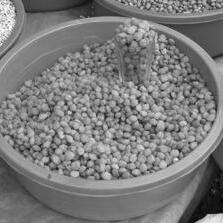Deciduous tree up to 40 m. high; trunk up to 25 m. high, and up to 1.5 m. in diameter 1.5 m. from the ground.. Bark rough, scaling, dark grey.. Wood soft, white, perishable.. Twigs up to 1 cm. diameter, sparsely lenticellate, densely ferruginous stellate-pubescent at first, soon glabrescent, with a thick pith.. Leaf-segments 3–7, elliptic-lanceolate to broadly elliptic, the median ones 10–30 cm. long, 5–15 cm. wide, the laterals somewhat smaller, long-acuminate to caudate-acuminate, acute, attenuate at base into the usually scarcely distinct pseudopetiolule, subentire or shallowly glandular-toothed, lateral nerves 15–25 pairs, glabrous or subglabrous above, subglabrous or initially or persistently densely silvery stellate-tomentose beneath, membranous.. Petiole 10–40 cm. long, with (0–)1–2 discoid glands ± halfway along on the adaxial surface, stellate-pubescent at first, soon glabrescent.. Stipules broadly flabelliform, 2–3(–5) cm. wide, with gland-tipped teeth 2–5 mm. long, palmately nerved, stellate-pubescent at first, soon glabrescent, persistent.. Male inflorescences 15–30(–40) cm. long, densely stellate-pubescent at first, soon glabrescent except in the axils of the branches; bracts subulate to linear, 3–7 mm. long, those in the lower part of the panicle, or occasionally all of them, with 1–3 globose, dark green glands on either side.. Male flowers: pedicels 1–2 mm. long, pubescent; sepals ovate, 3–4 mm. long, 2–3 mm. wide, pubescent without and within, greenish brown; petals ovate, 5–6 mm. long, 2–3 mm. wide, glabrous except for the pilose lower free margins, white, greenish white or pale yellow-green; disc-glands 4–6, ovate-suborbicular, yellow; stamens (7–)10–14, filaments inflexed in bud, later straightening and then 6 mm. long, anthers 0.75 mm. long.. Female inflorescences 6–10 cm. long, more robust than ♂; indumentum and bracts as in ♂.. Female flowers: pedicels 4–6 mm. long, pubescent; sepals and petals similar to those of ♂ but larger; disc crenellate, yellow-green; ovary 2–3-locular, globose, 5 mm. diameter, densely stellate-pubescent; styles 2–3, 4 mm. long.. Fruits 2–3-locular, bilobed or trilobed, 2–3-seeded, occasionally unlobed if one seed aborts, 2.5–3.5 cm. long, and 4–5 cm. wide when fresh, somewhat smaller when dried, glabrescent, green at first, becoming black when ripe.. Seeds compressed-subglobose, 1.3–1.7 cm. diameter, reddish brown.
More
A tree. It grows 40 m high. The trunk is straight and 2.7 m across. The bark is grey and smooth. It loses its leaves during the dry season. The leaves are like fingers on a hand and alternate. There are 3-5 leaflets and these are 6-30 cm long by 3-15 cm wide. Male and female flowers are on separate trees. There are 5 petals and 5 sepals and they are united in a tube. The fruit are small and green. They are 4 cm across. They have 2 lobes. There are 1-2 nuts.


